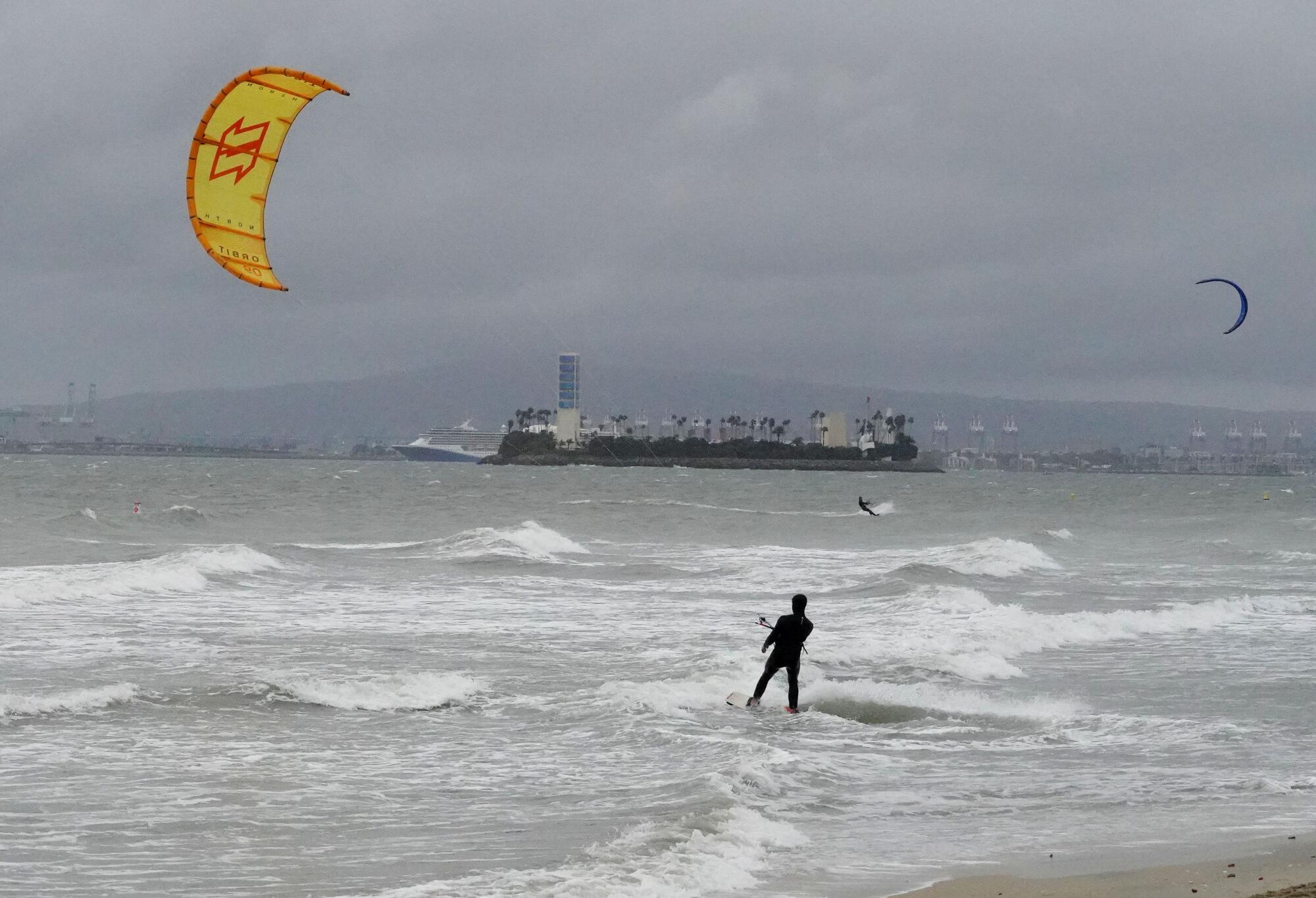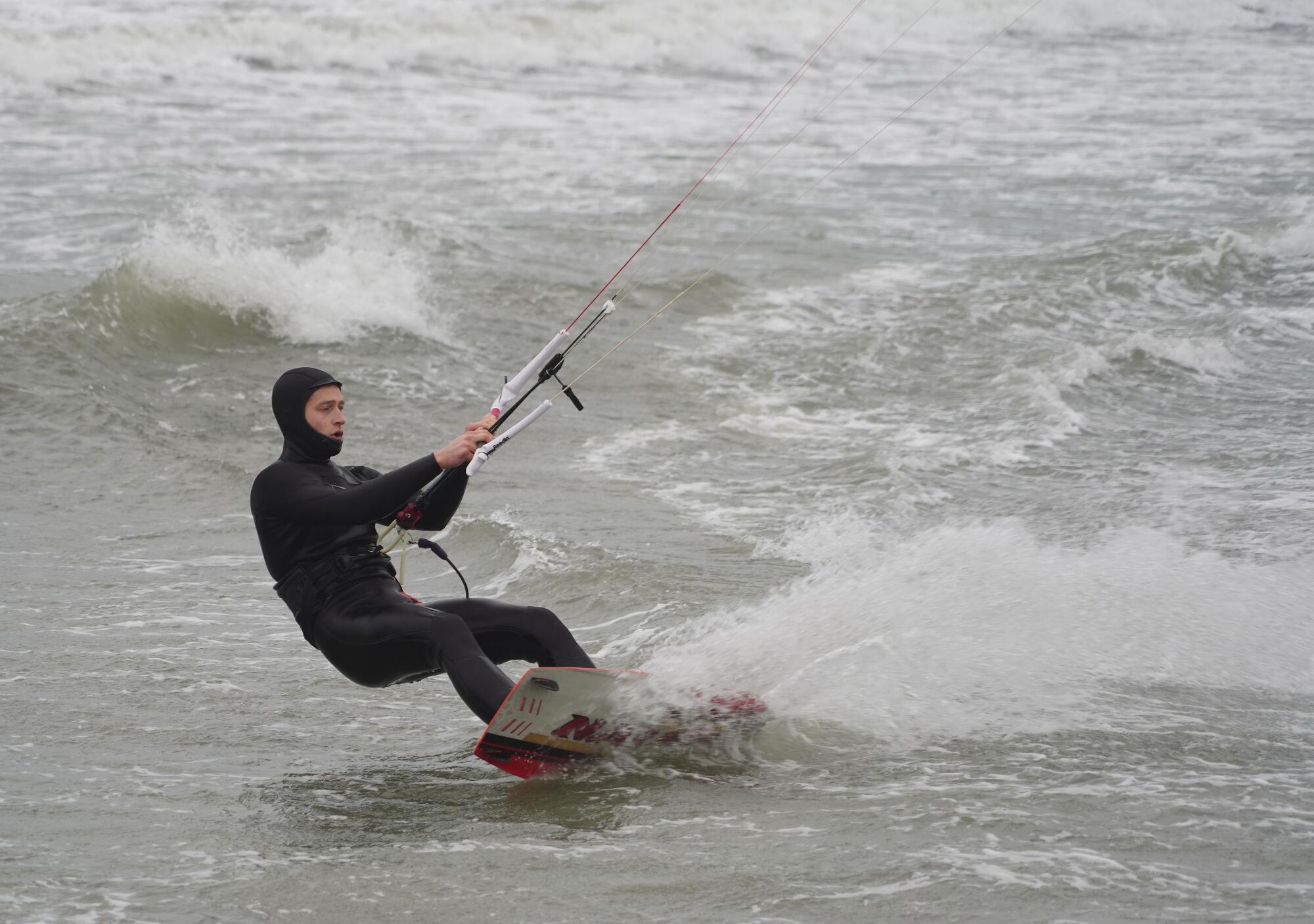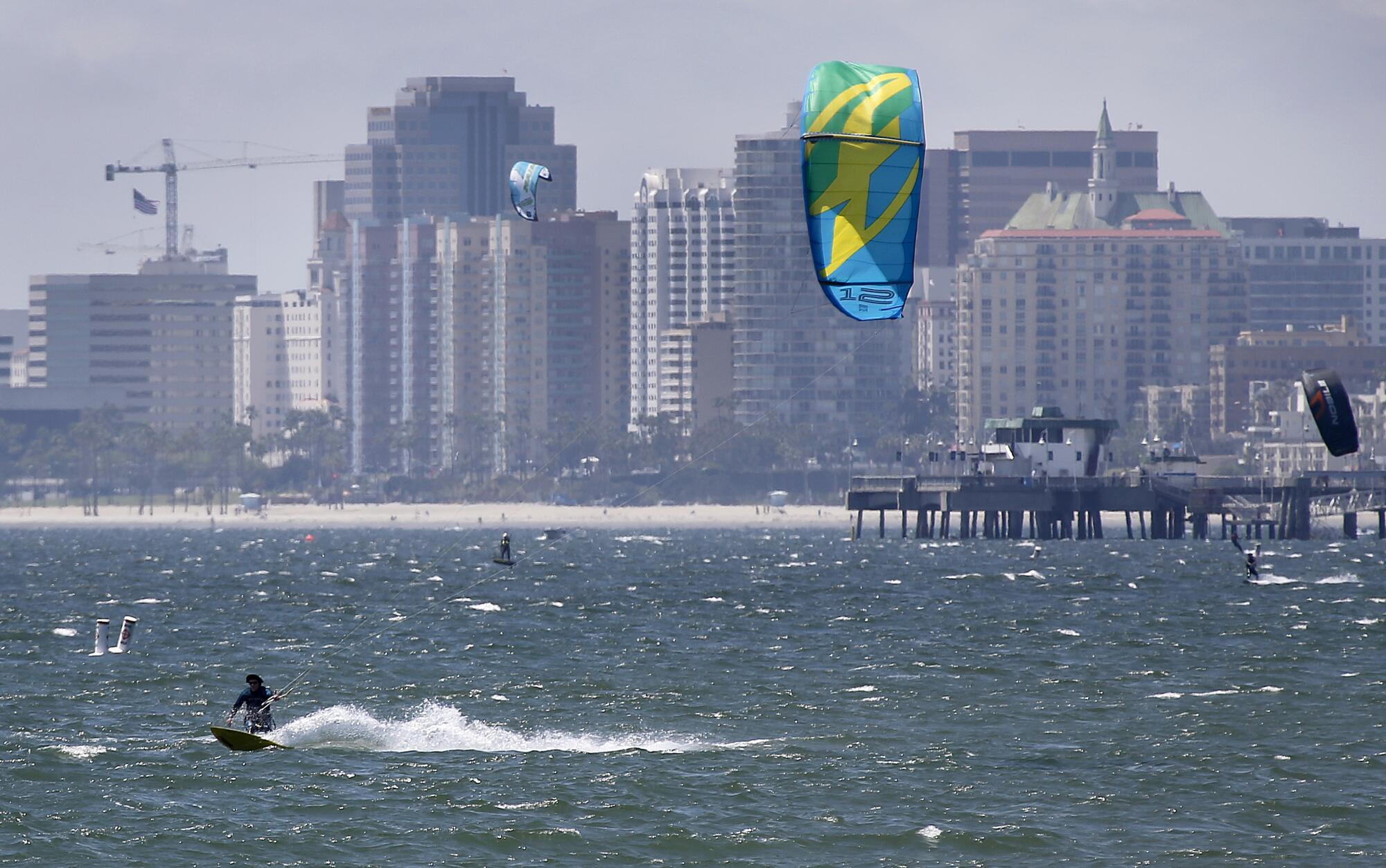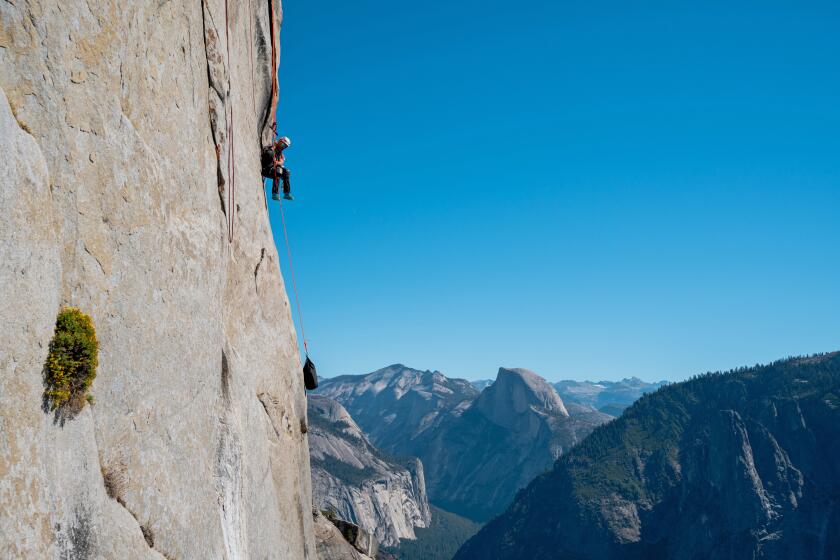
- Share via
As the atmospheric river barreled into Southern California on Sunday, cellphones throughout the region buzzed with dire alerts about the monster storm and imminent life-threatening floods. Across Los Angeles, last-minute shoppers, who were warned it soon could be too dangerous to drive, raced to grocery stores for emergency supplies.
But on Long Beach’s Belmont Shore, an unsung strip of sand in the far southern end of Los Angeles County, I stood with a small group of local kitesurfers huddled in thick wetsuits a few feet from the crashing waves, weighing our odds.
Strapping yourself to a giant kite and jumping into the ocean is never risk-free. But on a warm summer day with steady wind and predictable seas, Belmont Shore is one of the safest places in the country to learn the sport.
During winter storms, however, when the wind speed more than doubles and towering waves march in from an unusual direction, the otherwise welcoming bay can roar to life with the force you’d find in fabled extreme sports hot spots such as Maui’s wild North Shore or the Columbia River Gorge, nature’s perfect wind tunnel.
It gets so intense that last February, Long Beach kiter Giampiero Alferoni went from local hero to legend when he charged at an oncoming wave with nearly 50-mph winds howling in his ears and launched himself a breathtaking 101 feet into the air. His jump shattered the previous Belmont record by 30 feet and was the highest kitesurfing jump ever recorded in North America.
“I was just screaming, ‘Oh, my gosh, I don’t want to die,’” Alferoni, 56, a native of Italy, told me over espresso in a coffee shop near the beach this week.
He botched the landing — a common fate when you go so much higher than you expect — so he couldn’t walk right for weeks afterward. But he couldn’t stop smiling, either.
“Kitesurfing is a drug,” he said, stirring sugar into his tiny cup. “And, my God, it was strong that day.”

Alferoni’s spirit ran deep in those of us shivering in our wetsuits Sunday, trying to decide whether we should risk it.
The wind was already gusting well over 30 mph, with no clear limit on how strong it might get. The waves, some of them chest high, were breaking uncomfortably close to shore. That meant it would be game on as soon as your feet hit the water. Anyone who hesitated or made even the slightest mistake charging out through the whitewater would get slammed. They’d probably end up back on the beach, spitting sand and digging it out of their ear canals, before they even got started.
That possibility was running through my head as I broke from the huddle and started pumping air into my smallest kite, watching it transform from a limp rag into a beautifully curved and powerful wing. I was still hesitant as I attached one end of the 80-foot control lines to the kite and the other end to the harness around my waist. And I nearly called the whole thing off after a friend helped me launch and the kite rocketed overhead so violently it jerked me about a foot off the ground while I was just standing still.
But then I asked myself, what would Giampiero do?
Belmont Shore owes its reputation as a great beginner kite spot to a collection of variables that might seem unconnected to a casual observer.
First, the water is relatively flat thanks to a breakwater built two miles offshore in the 1940s to help protect the U.S. Navy’s Pacific fleet. Now, it keeps the surface calm for the regular stream of cargo ships that come and go from the Port of Long Beach.
Second, the steady coastal breeze that flows off the ocean onto land, from west to east, gets funneled between Catalina Island and the Palos Verdes Peninsula. That speeds the airflow up, squeezes it south and points it directly at Belmont Shore.
It doesn’t arrive with hurricane force, exactly, but there’s a noticeable bump. On afternoons when it’s blowing 10 to 12 mph in Redondo Beach to the north and Huntington Beach to the south, it’ll often blow 18 to 22 mph at Belmont.

That’s perfect for beginners to practice the intricate, addictive ballet of steering a kite through the air with their hands while guiding a board through the swell with their feet.
It’s also good for intermediate and expert kiters to work on more advanced moves, like jumps and aerial acrobatics, in conditions that will punish their mistakes but probably won’t kill them. That’s because the wind almost always blows toward the long and sandy shore. So a rider who loses the board, or crashes the kite into the water and can’t relaunch it, might have a long, exhausting swim home, but they will eventually wash up on dry land instead of being washed out to sea.
On most summer days, the biggest danger comes from stingrays that bury themselves just beneath the sand in knee-deep water near shore. Their barbs are like steak knives, and the deep puncture wounds they leave are prone to infection — it’s a gritty urban beach and the water is not the cleanest.
Getting stung is a rite of passage for Belmont kiters; one local has endured the pain more than two dozen times. Nothing short of chain mail seems to stop the barbs, but wrapping heavy metal around your feet would drastically increase the risk of drowning.
The most effective solution arrived by surprise a few years ago when, without warning or recent precedent, the bay suddenly became a nursery for about half a dozen juvenile great white sharks. The local kiters were terrified at first, but as the summer wore on and nobody got eaten — the sharks showed no interest in us whatsoever — we noticed that almost nobody was getting stung, either. The young sharks were gorging themselves on the hated stingrays.
Most of us were sorry when the sharks disappeared as suddenly, and mysteriously, as they had arrived.

All of which is to say, Belmont feels like a safe place. A lot of the locals know its moods, its wind, even its wildlife as intimately as they know their own families. But all that warm and fuzzy familiarity flows straight out the window when an atmospheric river blows in.
The first thing I noticed Sunday, after I braced for the cold and plunged in, was that everything felt a little off. With the wind coming from a strange direction, the southeast instead of the southwest, it was like driving a car on the wrong side of the road in England. Not hard, just weird and disorienting.
But there was no time to dwell on that, because, within seconds, the crashing whitewater threatened to rip the board from my feet and slam me face-first into the sand. I had to accelerate and carefully time a series of quick jumps to get over the breaking waves and out to smoother water.
Once there, the wind was significantly stronger than it was on the beach and the swells much bigger than they had appeared from shore. That’s normal, but it’s a matter of degrees.
On a typical summer day at Belmont, the swells come at you like smooth knee-high ramps. As you approach going about 15 to 20 mph, you can choose to bend your legs and absorb them like a mogul on a ski run, so your board stays in contact with the surface of the water, or keep your legs stiff and use the ramps to launch into the sky.
But on Sunday, the biggest swells were steep and nearly vertical, like racing walls of water, and their crests rose to eye level. Absorbing them was nearly impossible — and launching off them into the howling wind felt crazy.
Still, we had come for glory, so we didn’t have much choice.

A good kitesurfing jump is not as simple as hitting the ramp with your legs stiff; there are a lot of moving parts. While going as fast as you can, you have to drop the kite as close to the horizon as it will go without touching the water. Then you lean back against the kite’s pull, putting all your weight on your heels to dig the edge of the board firmly into the water. The idea is to create as much tension in the lines as possible, turning yourself into a human slingshot.
As you hit the ramp, you steer the kite as fast as it will go overhead and kick with your back foot as hard as you can to release all the tension at once. A million things can go wrong — it’s like trying to hit a dancing 90-mph fastball out of the park. But when everything connects, the effect is magical.
One second, you’re hammering along the chaotic undulating surface with frothing white spray in your face. The next, you’re rising, swiftly and silently, 20, 30, 40 feet into the sky.
Alferoni’s right, it is like a drug, but you don’t have much time to savor it.
A second or two later, you’re faced with the urgent task of turning your kite from a powerful wing into a parachute. You do that by steering it gently back and forth overhead to create enough lift to feather the landing. As with the takeoff, timing is everything.
When you’ve done it hundreds of times in familiar conditions, you develop an internal clock that’s freakishly reliable. For me, a 20-foot jump in normal Belmont wind means I’ll be in the air between four and five seconds. The rhythm is always the same: up, one, two — slight pause at the apex — down, three, four. It’s as steady as a metronome.
But that means if anything changes, if a gust hits on the count of three and instead of gently dropping you shoot up another 10 or 20 feet, adrenaline floods your brain and expletives fly from your mouth. You curl into a cannonball and pray for salvation.
After splashdown, you bob to the surface and hope the kite is still flying overhead and the board you kicked off in panic isn’t too far away. But you also smile, knowing the little tracking device attached to your board that measures your jumps probably just recorded a personal best.
In 2015, mountain guide Zuko Carrasco’s world collapsed in a trust fall gone awry. Eight years later, he looked to reclaim his independence with an audacious plan to scale El Capitan.
Alferoni, who is regularly the highest jumper at Belmont and now, statistically, one of the best in the world, experienced all that the day he broke 100 feet, just on a much grander scale.
He knew the jump was special instantly, long before he checked the tracking data, because all the local landmarks — the lifeguard towers, the sand dunes, the pricey homes that line the beach — are as familiar as his bedroom furniture. He’d seen them hundreds of times from the top of 30- and 40-foot jumps: about eye-level with the crowns of the palm trees closest to the launch site.
So after he hit that perfect ramp, and sent the kite as hard as he could overhead, he was shocked to look down and realize the tiny green dots so far below were the tops of those trees.
“I had four or five jumps that day almost as high,” he said, “I was just screaming the whole time, ‘Oh, my God, oh, my God!’ ”
Nobody came near his record last weekend: The highest jump recorded and posted to the app that tracks kitesurfing was just over 40 feet. I was so intimidated by the conditions, I hadn’t even charged my tracking device, but I doubt my best jump was even half that.

I was surprised I didn’t see Alferoni on the water. I’ve known him for almost 10 years and those were the conditions he seems to live for. So I texted him when I got home to ask if he was OK.
“I’m sorry, Jack, but the wind was not strong enough,” he replied. He’d decided instead to help a friend fix his leaky roof before the rain.
I learned the next day, over espresso, that the injury he suffered while setting the record had really worried him. His foot had turned the wrong color and a large vein on the inside of his leg was bulging and visible just under his skin. Doctors put him on blood thinners and warned him not to take any chances.
“At my age, I can’t risk that kind of injury, it takes too long to recover,” he said.
Apparently, the drug wears off.
More to Read
Sign up for Essential California
The most important California stories and recommendations in your inbox every morning.
You may occasionally receive promotional content from the Los Angeles Times.
















